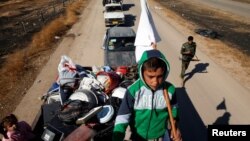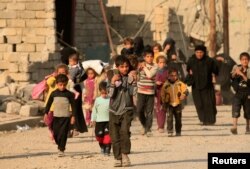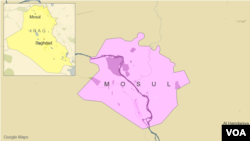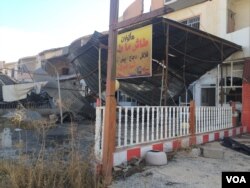U.N. human rights monitors in Iraq are uncovering growing evidence of multiple atrocities against civilians by Islamic State militants as the battle for Mosul advances. Abuses include widespread killings and torture, sexual exploitation of women and girls, and the recruitment of children as fighters and suicide bombers.
U.N. High Commissioner for Human Rights Zeid Ra’ad al-Hussein says the extent of civilian suffering in Mosul and other areas in Iraq occupied by Islamic State, also known as ISIL, is numbing and intolerable. He is calling for immediate action to make sure victims and survivors are protected and their needs are met.
The high commissioner’s spokeswoman, Ravina Shamdasani, says the U.N. has come across images of children being forced to carry out executions.
"ISIL also posted a video on Wednesday showing four children, believed to be between 10 and 14 years old, shooting to death four people for spying for the ISF [Iraqi Security Forces] and the Peshmerga. The video shows the victims falling into a river nearby," said Shamdasani.
Shamdasani says the children include one from Uzbekistan, one from Russia and two from Iraq. The U.N. reports mass killings appear to be commonplace. For instance, it says IS militants reportedly shot and killed 40 civilians in Mosul after accusing them of "treason and collaboration" with the Iraqi Security Forces.
More details are emerging of a mass grave containing the bodies of at least 100 people in an agricultural college building in Hamam al-Alil that was discovered on Monday. Shamdasani says the corpses are in various states of decomposition, indicating the site has been used as a killing ground for some time.
She says a number of incidents point to the use of chemical weapons by IS.
"One is the setting alight of this factory, the al-Mishrag Sulphur Gas Factory and Field, in the Shura sub-district of Mosul. Now, the factory was set on fire and it was shelled by ISIL. And we already have reports of people who have died as a result of the fumes that came out of this factory," said Shamdasani.
Shamdasani says there is evidence Islamic State is stockpiling large quantities of ammonia and sulfur in Mosul close to civilian areas. She says this is raising concern that IS intends to use chemical weapons against civilians as part of its strategy to hang on to Mosul.
In the meantime, aid agencies have been scaling up their operations in anticipation of a large upsurge of people fleeing Mosul. This hasn’t happened as of yet, with the U.N. reporting an exodus of only around 48,000 of Mosul’s population of more than one million.
But, the World Health Organization representative in Iraq, Altaf Musani, referred to the situation in the region as dynamic and said aid agencies had to be flexible and prepared for any eventuality.
Speaking on a telephone from his office in Baghdad, Musani said aid agencies have not yet been able to enter Mosul and were concentrating on providing shelter, food, health care and other necessities to those people who have managed to leave the city.
There are credible reports that IS militants are preventing civilians from leaving Mosul to use them as human shields against the entry of Iraqi forces into the city.
Musani said his agency was working to bring trauma and referral care as closely as possible to the city “because we anticipate that as the conflict intensifies, the casualties will be overwhelming.”
He said it was important to make sure that there was sufficient capacity to stabilize patients and send them to referral hospitals in nearby cities.
He said there was no accurate count of the number of dead and wounded, but an indication of the seriousness of the situation could be seen in the number of hospital patients. For example, he said the main hospital in Erbil, in Iraq's Kurdish region, had received 300 casualties in one seven-day period alone.
“This is just the tip of the iceberg,” Musani said. “We know that there are many more casualties that are either stranded in Mosul or in the outskirts of the city.” He said the injuries are very severe with civilians caught in the crossfire suffering from gunshot wounds, mine and mortar injuries.
“We have reports of young women and children as small as two years old with bullet wounds in their chest, with a young girl suffering from leg injuries due to explosives", he said.
The U.N. refugee agency has opened six camps, which can host 54,408 people with plans to open five more camps with a capacity to accommodate a total of 120,000 people.
Besides providing life-saving support, UNHCR spokesman William Spindler said his agency also was increasing protection, psychosocial and legal aid to internally displaced people. He told VOA that among those who have fled Mosul there appeared to be a “disproportionate number of female-headed households.”
He said, “we do not know the details of why this is happening — whether men are being held back or whether they have just been moving through different routes. In any case, this is something that is worrying and we are following it up closely.”














